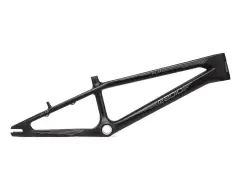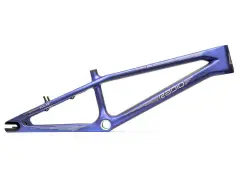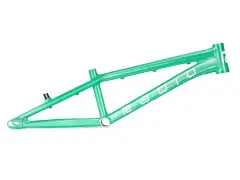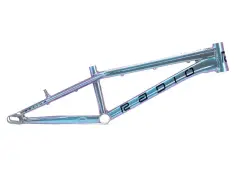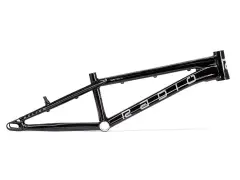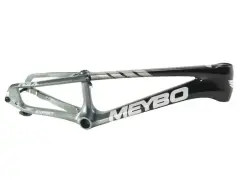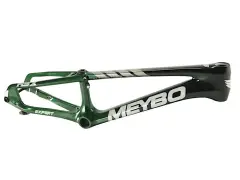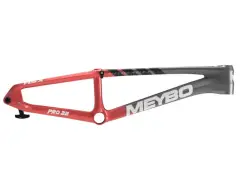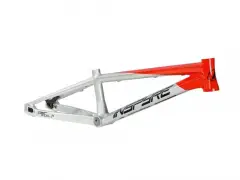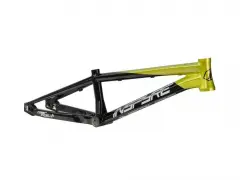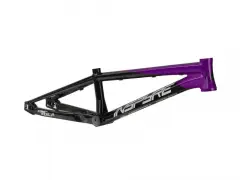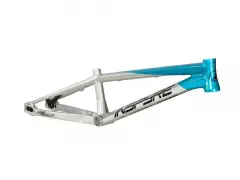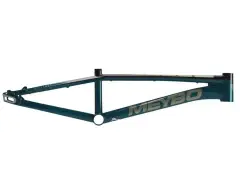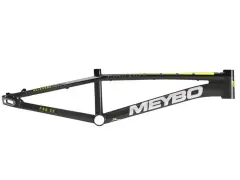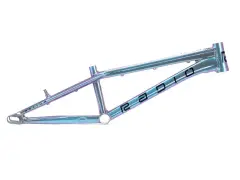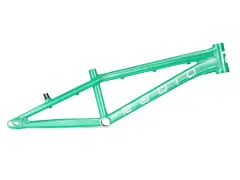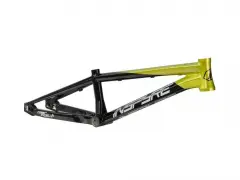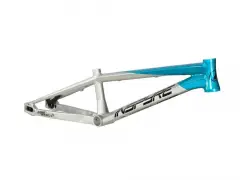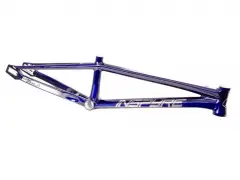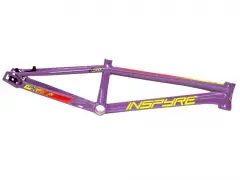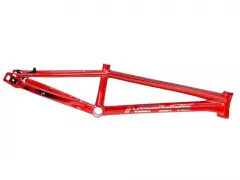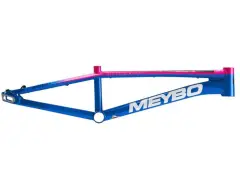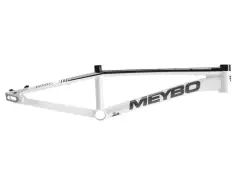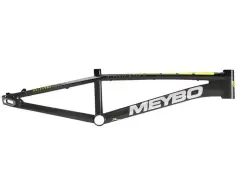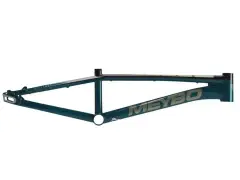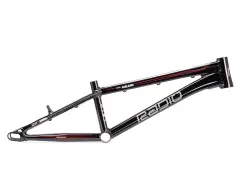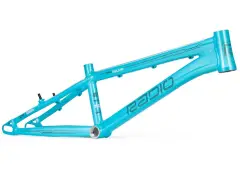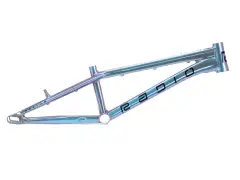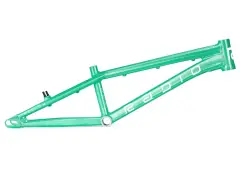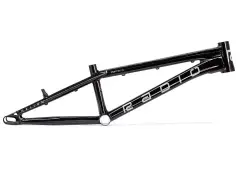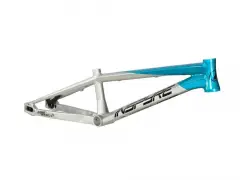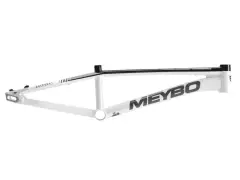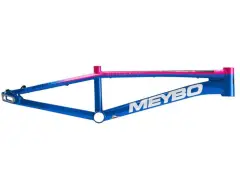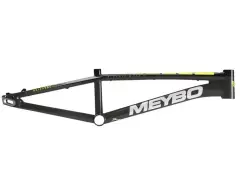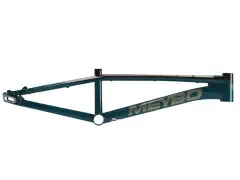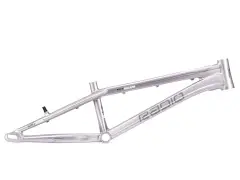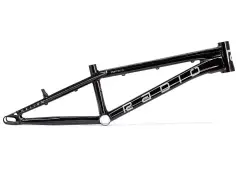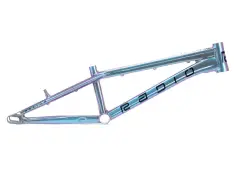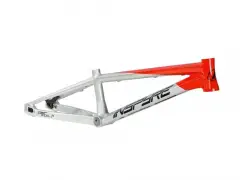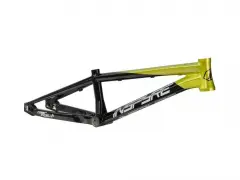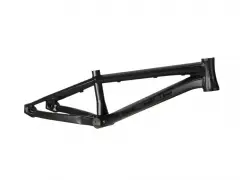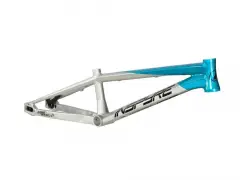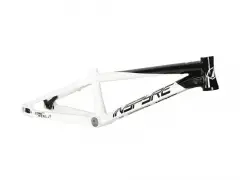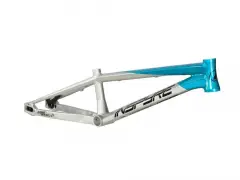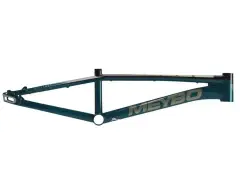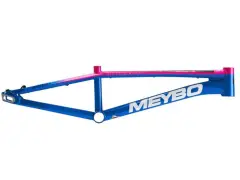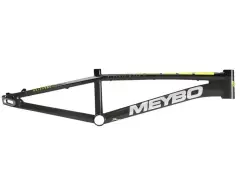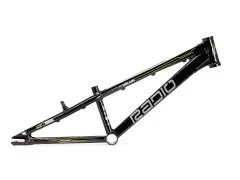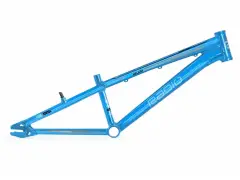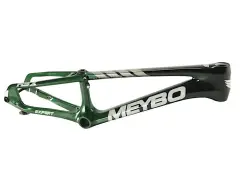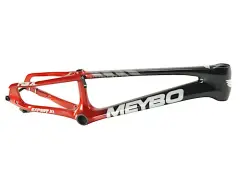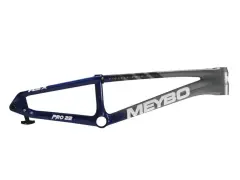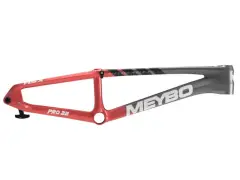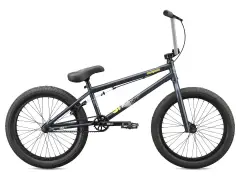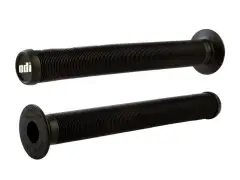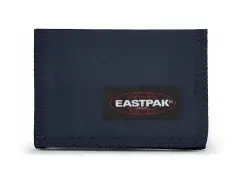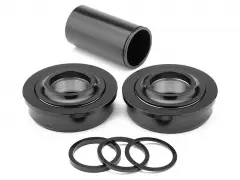BMX Race Frames
The foundation of your victory starts here. Whether you need a responsive Aluminium Frame for the Expert class or a high-end Carbon Frame for the Pro podium – the geometry decides the race. Use our detailed Size Guide below to find the perfect Top Tube Length for your height.
BMX Race Frames FAQBMX Race Frames Range
BMX Race Frames FAQ
What is a BMX Race Frame and what is its main purpose?
The Race Frame is the heart of your bike. Unlike freestyle frames, it is designed for maximum stiffness, low weight, and stability at high speeds. It dictates your body position, handling precision in corners, and power transfer out of the gate.
How is a Race Frame constructed?
- Head Tube
- Holds the Headset. Modern frames utilize Tapered (conical) head tubes for increased stiffness and better steering precision.
- Bottom Bracket Shell
- The center of power transfer. Race frames typically use Euro (BSA) or Press-Fit (BB86) standards to minimize flex.
- Dropouts
- The rear wheel mount. Available for 10mm, 15mm, or 20mm axles. Many modern frames feature enclosed dropouts with integrated chain tensioners.
Which BMX Race Frame size is right for me?
The correct frame size depends primarily on your body height. The Top Tube Length (TTL) is the fundamental measurement in BMX Race geometry.
Note: Unlike Freestyle BMX (where 20" wheels are constant), Race bikes scale the frame significantly to fit the rider – from Mini to Pro XXXXL.
| Frame Size | Top Tube Length (approx.) | Rider Height (approx.) | Wheel Size |
|---|---|---|---|
| Mini | 17.25" – 18.0" | up to 130cm | 20" |
| Junior | 18.0" – 19.0" | up to 150cm | 20" |
| Expert | 19.0" – 20.0" | up to 160cm | 20" |
| Expert XL | 20.0" – 20.5" | up to 170cm | 20" |
| Pro | 20.5" – 21.5" | up to 175cm | 20" |
| Pro XL | 21.0" – 22.0" | from 175cm | 20" |
| Pro XXL | 21.5" – 22.5" | from 185cm | 20" |
| Pro XXXL | 22.0" – 22.5" | from 190cm | 20" |
| Pro XXXXL | 22.5" and larger | from 195cm | 20" |
| Cruiser | 21.0" – 23.0" | from 165cm | 24" |
Why is the Top Tube Length crucial when choosing a BMX Race Frame?
The Top Tube Length (TTL) is a fundamental measurement in the geometry of a BMX Race bike and has a direct and decisive influence on the rider's control and power transfer efficiency. Its importance cannot be overstated, as it significantly determines the riding position and thus the performance on the track.
Impact on Control
A top tube length that is precisely matched to the rider is essential for mastering the bike in all racing situations:
- Optimal Weight Distribution: The TTL optimally positions the rider's center of gravity over the bicycle. If the top tube is too short, the rider sits too upright and cramped, which increases the load on the rear wheel and makes the front wheel too light. This can impair tracking stability and make the bike feel unstable in fast sections or during landings. A TTL that is too long, on the other hand, forces the rider into an overly stretched position, which makes steering more difficult and reduces intuitive control, especially when manualling or in tight corners.
- Improved Handling: A correct top tube length allows the rider to react quickly and precisely to the demands of the track. The arms are at an optimal angle to provide steering input and absorb impacts, which is essential for agility in rhythm sections and stability during jumps and in berms.
Impact on Power Transfer
In BMX Race, every watt counts. The top tube length plays a central role in the direct and efficient conversion of muscle power:
- Ergonomic Pedaling Position: The length of the top tube influences the distance between the saddle and handlebars and thus the rider's hip angle when pedaling. A suitable hip angle allows the large muscle groups of the legs and torso to be used without restriction and with maximum force.
- Instant Power: A top tube length that is too short or too long can negatively affect the biomechanics of the pedal stroke. The rider cannot apply full force to the pedals because the range of motion is restricted or the body is working in an unfavorable position. The optimal TTL, however, ensures that all of the rider's energy flows directly into the bike's propulsion, which is particularly noticeable at the start, when accelerating out of corners, and in the final sprint.
In summary, the top tube length is not just a number, but a decisive factor for the ergonomic fit, dynamic control, and maximum power delivery in BMX Race. It forms the basis for confident riding performance and is therefore a central criterion in individual bike fitting.
Is a Carbon BMX Race Frame worth it compared to Aluminum?
A Carbon Frame is the top choice for racers who compete at the highest level and want to use every gram of weight savings and every stiffness optimization for that decisive advantage. The investment is significant but is rewarded with maximum performance and an exclusive ride feel. Aluminum Frames, on the other hand, offer excellent value for money. They are robust, light enough for ambitious racing, and are more forgiving of crashes. For most riders, especially beginners and advanced racers looking for a reliable and low-maintenance race bike, aluminum remains the more pragmatic and often completely sufficient choice.
| Property | Aluminum Frame | Carbon Frame |
|---|---|---|
| Weight | Low. Relatively light, but noticeably heavier than carbon. | Very Low. Significantly lighter, saves valuable milliseconds. |
| Stiffness | High. Good power transfer, but with more flex than carbon. | Extremely High. Optimal power transfer, more direct ride feel. |
| Vibration Damping | Moderate. Transmits more impacts to the rider, can be fatiguing. | Very Good. Absorbs shocks and vibrations better, increases ride comfort. |
| Durability | Very High. Robust, more forgiving of crashes and impacts. Dents can affect stiffness. | High. Very robust with proper use and without point impacts. Scratches are not critical, but crashes onto sharp edges can cause structural damage. |
| Price | Medium. Significantly cheaper and more budget-friendly. | Very High. Premium segment, a major investment. |
| Reparability | Good. Minor damages are often easier to repair or straighten. | Complex & Expensive. Specialized repair is elaborate and not always possible. |
| Aesthetics | Classic tube shapes, usually with clean welds. | Often distinctive shapes due to the molding process, high-quality finishes. |
| Ideal Rider | All types of riders, from beginners to ambitious racers looking for a robust and affordable bike. | Competition-focused racers who are seeking that last ounce of performance and are willing to invest in it. |
How do I assemble a BMX Race Frame?
- Prep: Grease the bottom bracket threads/seats and the headset cups/seats.
- Install Bearings: Press in the Bottom Bracket and Headset carefully.
- Install Fork: Slide the fork through and install the stem to hold it.
- Drivetrain: Install cranks, chainring, and chain.
- Rear Wheel: Install the wheel and adjust the chain tensioners for perfect alignment.
What do the specifications mean?
| Specification | Explanation | Examples/Available |
|---|---|---|
| Top Tube (TT) | Length from Head Tube to Seat Tube. | 20.5" (Pro), 21.75" (Pro XXL) |
| Chain Stay (CS) | Rear end length. Affects manualing. | 14.5" - 15.5" (Pro sizes) |
| Head Tube Angle | Steering responsiveness. | 74° (Stable), 74.5° (Responsive) |
| Seat Post Ø | Required post diameter. | 22.2mm (Mini), 27.2mm (Pro) |
